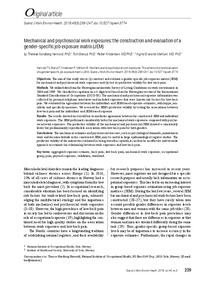Mechanical and psychosocial work exposures: the construction and evaluation of a gender-specific job exposure matrix (JEM)

Nordberg Hanvold, Therese ; Sterud, Tom ; Kristensen, Petter ; Sivesind Mehlum, Ingrid
Scandinavian Journal of Work, Environment and Health
2019
45
3
239-247
exposure assessment ; psychosocial risks ; physical risks ; workload assessment ; job exposure relation ; gender
Risk assessment and risk management
http://dx.doi.org/10.5271/sjweh.3774
English
Bibliogr.
"Objectives The aim of this study was to (i) construct and evaluate a gender-specific job exposure matrix (JEM) for mechanical and psychosocial work exposures and (ii) test its predictive validity for low-back pain.
Methods We utilized data from the Norwegian nationwide Survey of Living Conditions on work environment in 2006 and 2009. We classified occupations on a 4-digit level based on the Norwegian version of the International Standard Classification of Occupations (ISCO-88). The mechanical and psychosocial exposure information was collected by personal telephone interviews and included exposures that were known risk factors for low-back pain. We evaluated the agreement between the individual- and JEM-based exposure estimates, with kappa, sensitivity and specificity measures. We assessed the JEM`s predictive validity by testing the associations between low-back pain and the individual- and JEM-based exposure.
Results The results showed an overall fair-to-moderate agreement between the constructed JEM and individual work exposures. The JEM performed considerably better for mechanical work exposures compared with psychosocial work exposures. The predictive validity of the mechanical and psychosocial JEM showed a consistently lower but predominantly reproducible association with low-back pain for both genders.
Conclusions The mechanical estimates and psychosocial stressors, such as psychological demands, monotonous work and decision latitude in the constructed JEM, may be useful in large epidemiological register studies. The predictive validity of the matrix was evaluated as being overall acceptable, it can thus be an effective and versatile approach to estimate the relationship between work exposures and low-back pain."
Digital
The ETUI is co-funded by the European Union. Views and opinions expressed are however those of the author(s) only and do not necessarily reflect those of the European Union or the ETUI.